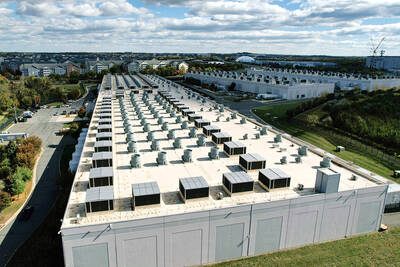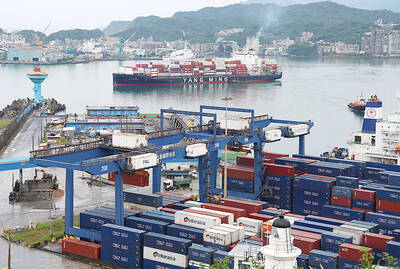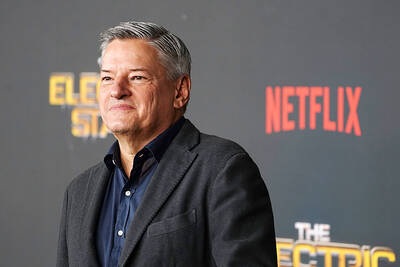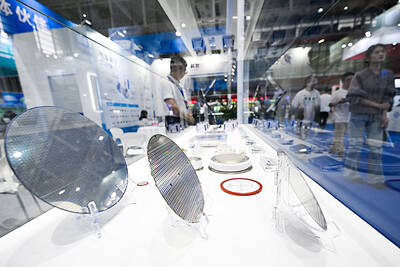After French President Emmanuel Macron scrapped plans for a high-speed rail connection to Limoges, a city in central France, local entrepreneur Fabien Thibaut picked up his telephone to call Tesla Inc chief executive officer Elon Musk and talk about the hyperloop — Musk’s idea for superfast trains zooming in tubes.
“This kind of project is essential for a city like ours,” said Thibaut, one of many in France who wants to bring home a piece of Musk’s idea. “We have nothing here — this would bring companies, jobs, tourism.”
In the country that invented high-speed TGV trains and the supersonic Concorde plane, Thibaut had no trouble drumming up support from others, including the deputy mayor.
However, with the French government keen on cutting public spending, officials in cities, such as Limoges, Orleans and Toulouse, are seeking cheaper approaches to futuristic transport, pitching themselves as hotbeds for testing.
While they cannot put fat checks on the table, French cities are relying on handouts of real estate, tax cuts for engineering talent and some limited subsidies to attract hyperloop-inspired projects.
“Any hyperloop project will need government support whatever happens,” said Serhiy Yarusevych, a mechanical engineering professor at the University of Waterloo in Canada. “There are no breakthroughs required on the technology side. What will matter is the funding for land, infrastructure and R&D [research and development].”
Musk’s idea is not new — French novelist Jules Verne imagined pneumatic pods crossing oceans in tunnels at 1,496km per hour a century and a half ago — but since he laid out the concept of the hyperloop in 2013, a flurry of initiatives has emerged.
Musk’s space company, SpaceX, has organized student competitions to build prototypes, while British tycoon Richard Branson is backing the troubled Virgin Hyperloop One, which is itself working with German automaker BMW AG in Dubai.
Two other Los Angeles start-ups, Hyperloop Transportation Technologies (HTT) and Arrivo Corp, also are developing similar concepts.
So, while Musk never returned Thibaut’s call, a Canadian start-up called TransPod Inc did.
TransPod’s technology is based on magnetic propulsion and electrified tracks, moving pods through a vacuum tunnel designed to reduce friction. As with most hyperloop projects, the bulk of the estimated costs are for deploying infrastructure.
TransPod co-founder Sebastien Gendron estimated that his company needs 20 million euros (US$24.2 million) in financing to complete the Limoges project at the current stage, and said that he is planning to raise half of that from private investors.
In Limoges, discussions have zoomed in on the prospect of building a 3km test track and a 15-person research center as TransPod seeks subsidies from government-backed structures in the region as well as from the EU.
Limoges Mayor Emile Roger Lombertie said in an interview that TransPod must first find venture capital investors before the city jumps in to help with financing.
It is now providing administrative support.
TransPod got a green light from another local authority to use retired rail tracks free of cost.
The fate of the project is hanging on a decision by authorities about whether an environmental study is needed, chief executive officer Gendron said.
About 240km north, another city, Orleans, also took to the hyperloop after years of unsuccessful lobbying to get a high-speed link to the French capital.
The mayor’s office reached out to a French entrepreneur called Emeuric Gleizes who is aiming to develop an air train by 2025.
While there is little chance Orleans will offer up a chunky jackpot for his SpaceTrain, Gleizes is hoping to get free access to 18km of unused train tracks in the region to test a prototype, in a deal similar to TransPod’s in Limoges.
To reduce development costs, SpaceTrain ditched the idea of a tunnel and instead would move carbon-fiber shuttles carrying as many as 40 passengers at 540kph using a method based on air cushions, often employed by industrial companies to move heavy objects.
Orleans also rang up HTT, which has made announcements about planning a 10km Hyperloop route in Abu Dhabi and a research lab in Brazil.
In southwestern France, Toulouse, the home of planemaker Airbus SE and heaps of aeronautics experts, is preparing to host an experiment by HTT.
“France is one of the best European countries when it comes to supporting start-ups and innovation,” HTT co-founder Dirk Ahlborn said. “Of course France isn’t the country where everything happens the fastest — if the [United Arab] Emirates wants something, for example, if will happen.”
In France, Ahlborn is eyeing public funding for innovation, and said HTT would hire 15 people at a research lab in Toulouse.
Local authorities have awarded HTT access to a former army base with a free lease that spans over 40 years, in exchange for refurbishment and de-pollution work, including removing bombs from World War II.
The goal is to put together by the end of the year a track that is 320m long that has tubes sitting on pylons almost 6m high. The installation could later be extended to 1km.
HTT, which missed a deadline to open a test center in California two years ago, said the Toulouse system could be ready within three years.
So far, gray tubes about 4m high have been hauled by truck from Spain to Toulouse.

The demise of the coal industry left the US’ Appalachian region in tatters, with lost jobs, spoiled water and countless kilometers of abandoned underground mines. Now entrepreneurs are eyeing the rural region with ambitious visions to rebuild its economy by converting old mines into solar power systems and data centers that could help fuel the increasing power demands of the artificial intelligence (AI) boom. One such project is underway by a non-profit team calling itself Energy DELTA (Discovery, Education, Learning and Technology Accelerator) Lab, which is looking to develop energy sources on about 26,305 hectares of old coal land in

Taiwan’s exports soared 56 percent year-on-year to an all-time high of US$64.05 billion last month, propelled by surging global demand for artificial intelligence (AI), high-performance computing and cloud service infrastructure, the Ministry of Finance said yesterday. Department of Statistics Director-General Beatrice Tsai (蔡美娜) called the figure an unexpected upside surprise, citing a wave of technology orders from overseas customers alongside the usual year-end shopping season for technology products. Growth is likely to remain strong this month, she said, projecting a 40 percent to 45 percent expansion on an annual basis. The outperformance could prompt the Directorate-General of Budget, Accounting and

Netflix on Friday faced fierce criticism over its blockbuster deal to acquire Warner Bros Discovery. The streaming giant is already viewed as a pariah in some Hollywood circles, largely due to its reluctance to release content in theaters and its disruption of traditional industry practices. As Netflix emerged as the likely winning bidder for Warner Bros — the studio behind Casablanca, the Harry Potter movies and Friends — Hollywood’s elite launched an aggressive campaign against the acquisition. Titanic director James Cameron called the buyout a “disaster,” while a group of prominent producers are lobbying US Congress to oppose the deal,

Two Chinese chipmakers are attracting strong retail investor demand, buoyed by industry peer Moore Threads Technology Co’s (摩爾線程) stellar debut. The retail portion of MetaX Integrated Circuits (Shanghai) Co’s (上海沐曦) upcoming initial public offering (IPO) was 2,986 times oversubscribed on Friday, according to a filing. Meanwhile, Beijing Onmicro Electronics Co (北京昂瑞微), which makes radio frequency chips, was 2,899 times oversubscribed on Friday, its filing showed. The bids coincided with Moore Threads’ trading debut, which surged 425 percent on Friday after raising 8 billion yuan (US$1.13 billion) on bets that the company could emerge as a viable local competitor to Nvidia